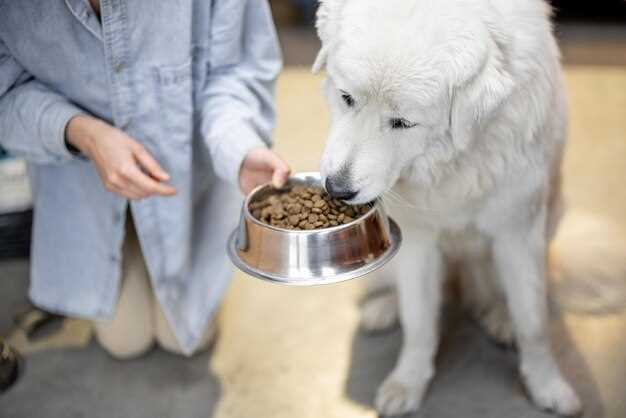Start your quest for the perfect dog food by focusing on the ingredient list. This section provides the most reliable insight into what you’re really feeding your furry friend. Look for specific meats like chicken, beef, or fish as the primary ingredient. Avoid products listing generic terms such as “meat meal” or “animal byproducts,” which can include a mix of low-quality sources.
Turn your attention to the nutritional adequacy statement, often marked by phrases like “complete and balanced.” This detail is crucial as it indicates the food meets the minimum nutritional levels established by the Association of American Feed Control Officials (AAFCO). Make sure the food supports your pet’s life stage, whether they are a growing puppy or a mature adult.
Scrutinize marketing claims with a critical eye. Terms like “natural” and “premium” may not carry much weight, as they are not strictly regulated. Instead, focus on product certifications and endorsements from reputable pet health organizations. These seals of approval can provide assurance of quality and safety standards.
Decoding Common Claims and Terms on Dog Food Labels

Check for specific protein sources, like “chicken” or “beef,” on the label for clarity on the meat content. Avoid vague terms like “meat by-products,” as these can be ambiguous about quality. A “complete and balanced” claim means the food meets nutritional standards set by the AAFCO, ensuring it’s formulated to be a primary diet. However, this doesn’t equate to premium quality, so scrutinize ingredient lists for fillers such as corn or soy, which may imply lower nutritional value.
Ingredients listed as “human-grade” imply the food adheres to standards fit for human consumption, though it’s not a regulated term. Reviews can help confirm their authenticity, but for trustworthy choices, look for companies with consistent quality assurances. “Grain-free” isn’t always synonymous with healthier options. Unless your dog has specific grain allergies, this might not be the most beneficial choice.
| Claim | Meaning |
|---|---|
| Organic | Ingredients are grown without synthetic fertilizers or pesticides but don’t assume superior nutrition. |
| High Protein | Highlights increased protein content; verify the source to ensure it’s from quality meats and not fillers. |
| No Artificial Preservatives | Free from synthetic preservatives. Look for natural alternatives like vitamin E or vitamin C. |
Be wary of “premium” and “gourmet” labels; these aren’t regulated and don’t necessarily guarantee higher quality. Always prioritize ingredient quality over catchy marketing terms, and consult your veterinarian when introducing a new diet to ensure it aligns with your dog’s health needs.
Understanding ‘All-Natural’ and Its Implications

Choose pet foods labeled as all-natural carefully by evaluating the ingredient list comprehensively. Many companies may use this claim without stringent regulations. Focus on specific ingredients that are easily recognizable like chicken, beef, carrots, and rice.
Avoid ingredients listed under vague terms such as “natural flavors” or those with chemical-sounding names like propylene glycol or BHA. These often suggest artificial additives or preservatives despite the “natural” label. Ensure proteins are named sources; for instance, prefer “chicken” over “meat meal”.
Check for actual certification stamps that guarantee oversight, such as those from USDA organic criteria or similar trusted standards. Identify whether the product avoids controversial fillers like corn or soy, commonly used as bulking agents without nutritional benefits.
Contact the manufacturer directly for clarity about their sourcing and production standards. Genuine companies are transparent about processes and easily provide additional information regarding their “all-natural” claims.
Pursue reviews and recommendations from trusted veterinary nutritionists or animal health professionals. They provide insights into the reliability and nutritional adequacy of the “all-natural” pet food options available.
The Truth Behind ‘Grain-Free’ Labels
Check the ingredient list thoroughly. Despite the ‘grain-free’ claims, many products replace grains with other high-carbohydrate fillers like potatoes, peas, or lentils. These can sometimes lead to the same issues they aim to avoid, such as weight gain and potential digestive problems.
Consult with your veterinarian before making a switch. While some dogs may benefit from grain-free diets due to specific allergies, grains like rice or oats are often healthy carbohydrate sources for most dogs. A balanced diet should cater to your pet’s individual health needs rather than trends.
Be aware of recent studies scrutinizing grain-free diets. Some research links grain-free diets with heart disease in dogs, specifically dilated cardiomyopathy (DCM). The FDA and veterinary communities continue to investigate these concerns, so staying informed through reliable sources is key.
Ensure that the diet is nutritionally complete. Grain-free labels can divert attention from other essential nutrients your dog needs. Look for foods that provide a balance of protein, fats, vitamins, and minerals to support overall health and well-being.
Evaluate your dog’s response over time. Transitioning to a new diet can take several weeks, and monitoring your dog’s digestion, energy levels, and coat condition will help determine whether the grain-free option is beneficial. Regular check-ups with your vet can guide necessary dietary adjustments.
‘Organic’ Certifications: What They Truly Guarantee
Choose pet food with the USDA Organic seal to ensure it meets strict criteria: 95% of the ingredients must be organically produced. This label guarantees no synthetic pesticides, fertilizers, or genetically modified organisms are used in the primary components, providing a cleaner and safer option for your dog.
Organic certifications also require that animal ingredients in the dog food come from animals not given antibiotics or growth hormones. This minimizes the risk of your pet ingesting potentially harmful residues, supporting their overall health.
Look for specifics on the ingredient list. If a product claims to be “made with organic ingredients,” at least 70% of the components must be organic. Understanding these terms helps you select products that align with your expectations for truly organic nutrition.
For products labeled as “organic,” remember that the remaining non-organic ingredients must be on an approved list, ensuring they still meet certain safety and health standards. This balances nutritional value and safety, giving you confidence in your pet’s diet.
By choosing organic-certified dog food, you’re not just selecting a label on a packaging–you’re opting for higher standards in agricultural practices and animal welfare. This means supporting sustainable practices and potentially enhancing your dog’s well-being through natural, responsibly sourced ingredients.
The Reality of ‘Vet-Approved’ and ‘Scientifically Formulated’ Products
Choose pet foods that list specific veterinarians or organizations involved in the approval process. A vague ‘vet-approved’ label without such information might indicate questionable endorsements. Examine whether these vets specialize in animal nutrition as this can significantly influence product quality.
‘Scientifically formulated’ implies backing by research or formulation by experts in animal nutrition. Verify these claims by looking for references to the studies or organizations that supported the formulation. This is a strong indicator of the brand’s commitment to transparency and quality standards.
Investigate the credentials and transparency of the brands that claim these endorsements. Reputable companies will provide detailed information on their packaging or websites about the formulation process and the experts involved.
Vet your choices by consulting with your own veterinarian, who can offer recommendations based on the specific dietary needs and health conditions of your pet, thereby ensuring the product aligns with their nutritional requirements.
‘Human-Grade’ Ingredients: A Closer Look
Prioritize quality by checking if the ingredients labeled as ‘human-grade’ are sourced from facilities approved for human food production. This ensures a higher standard of hygiene and safety. Evaluate the ingredient list for whole foods rather than by-products; terms like ‘chicken’ or ‘beef’ should clearly specify the cuts, avoiding generic terms like ‘meat meal’ or ‘animal fat’. Seek out foods with labels indicating adherence to AAFCO standards, as these guide nutritional adequacy.
To guarantee transparency and authenticity, research brands that provide detailed sourcing information. Brands committed to human-grade quality are often open about their partnerships with farms and suppliers. This transparency extends to sustainability practices, which contribute to ethical considerations alongside nutritional benefits.
Review any claims made about the ingredients. Ingredients positioned as ‘human-grade’ should provide benefits linked to digestibility and nutrient availability. Foods claiming to contain human-grade ingredients often boast fewer fillers and unnecessary additives, aiding in better digestion and nutrient absorption in your pet.
Trust established brands with clear sourcing and quality control processes, as these companies often invest in third-party testing to validate their quality claims. Finally, observe your pet’s health and energy levels as a measure of the food’s impact, as a diet of genuine high-quality ingredients should reflect positively in your pet’s overall well-being.
Puppy Ingredient Analysis: Ensuring Optimal Nutrition for Young Dogs

Prioritize high-quality protein sources when selecting food for your puppy. Look for ingredients like chicken, beef, or fish listed as the first ingredient. Protein supports muscle development and energy levels essential for active puppies.
Include foods with DHA, an omega-3 fatty acid crucial for brain and vision development. Ingredients such as fish oil or eggs are rich in DHA and beneficial for growing puppies.
Ensure the puppy food contains balanced calcium and phosphorus levels. These minerals are vital for strong bone growth. Check the label for appropriate ratios, aiming for a balance that supports healthy skeletal development.
Consider the presence of wholesome grains like brown rice or oatmeal, which deliver necessary carbohydrates for energy. However, if your puppy shows signs of sensitivity, opt for grain-free options with alternative carbohydrates like sweet potatoes or legumes.
Be wary of artificial additives and preservatives. Opt for natural preservatives such as mixed tocopherols, which maintain freshness without compromising nutritional value.
Finally, evaluate the presence of beneficial probiotics and prebiotics. These ingredients enhance digestive health and strengthen the immune system, ensuring your puppy thrives.
Key Nutritional Requirements for Puppies
Ensure that your puppy receives a diet rich in protein, as it is essential for muscle development and overall growth. Aim for a minimum of 22% protein in their food.
- Fat: Healthy fats, making up at least 8% of the diet, are vital for energy and healthy skin and coat. Look for omega-3 and omega-6 fatty acids for optimal brain and vision development.
- Calcium and Phosphorus: Balance is key for bone development. The recommended calcium to phosphorus ratio is approximately 1.2:1.
- Carbohydrates: While not as crucial as protein or fat, carbohydrates provide energy and should derive from high-quality sources such as whole grains or vegetables.
- Vitamins and Minerals: Essential for immune function and overall health. Key vitamins include A, D, E, and B-complex, alongside minerals like zinc, iron, and potassium.
- Water: Always available fresh water is necessary to prevent dehydration and aid in digestion.
Select puppy foods labeled with an Association of American Feed Control Officials (AAFCO) statement of nutritional adequacy. This ensures the product meets the established nutritional standards appropriate for growth. Regularly consult with a veterinarian to tailor the diet as your puppy grows, monitoring their weight and adjusting portions accordingly.
Identifying Quality Protein Sources for Growth
Prioritize named meat sources such as chicken, beef, or lamb as the first ingredient on dog food labels. These whole proteins support muscle development and are generally easier to digest.
- Ensure meats are identified clearly: Ingredients like “chicken” and “beef” guarantee you are getting a specific meat source rather than a byproduct.
- Look for foods that feature two or more types of whole meats or meat meals high on the ingredient list, which indicates a higher protein content.
Integrate foods containing fish or fish meals, as they are rich in omega-3 fatty acids, beneficial for your dog’s skin and coat health. Salmon and tuna are excellent examples.
- Include egg products, which provide complete proteins and are easily digestible. Whole eggs and egg yolks offer a comprehensive amino acid profile.
Avoid ambiguous terms like “meat meal” or “animal by-product,” which can mask lower-quality ingredients. These terms often indicate mixed origins and a less reliable source.
Consider alternative protein sources like venison or duck, which are excellent options for dogs with common protein allergies. They provide the necessary nutrients without causing allergic reactions.
- Incorporate legumes and lentils carefully; while they add protein, they shouldn’t replace animal proteins but rather complement them.
Evaluate the overall nutritional balance by checking if the food meets AAFCO standards, ensuring it provides all vital nutrients for growth and maintenance.
The Role of Fats and Carbohydrates in Puppy Diets
Prioritize feeding your puppy a balanced diet rich in essential fats and carbohydrates for optimal growth and energy. Fats serve as a significant energy source, more than doubling the energy yield from the same amount of proteins or carbohydrates. This energy is crucial for a puppy’s rapid growth and high activity levels. Moreover, fats aid in the absorption of fat-soluble vitamins like A, D, E, and K, which are vital for bone development and immune function.
Include high-quality sources of fat such as chicken fat, fish oil, or flaxseed, which offer beneficial omega-3 and omega-6 fatty acids. These components support cognitive development and help maintain a healthy coat and skin. When choosing food, ensure that fats constitute about 8% of the puppy’s diet, aligning with guidance from veterinary nutritionists.
Carbohydrates provide an additional energy source, with whole grains and vegetables delivering fiber and essential nutrients. Puppies benefit from carbohydrates like sweet potatoes and brown rice, which digest slowly and provide sustained energy release. Aim for carbohydrates to make up roughly 20% of the diet, keeping your puppy energetic and supporting healthy digestion.
Balance is key; while fats and carbohydrates play critical roles, monitor portion sizes to prevent obesity. Consult with a veterinarian for personalized dietary recommendations tailored to your puppy’s specific needs, accounting for breed, size, and activity level.
Q&A:

What does the term “complete and balanced” mean on dog food labels?
The phrase “complete and balanced” on dog food labels indicates that the food has been formulated to meet the nutritional levels established by the AAFCO’s (Association of American Feed Control Officials) Dog Food Nutrient Profiles. This means the product provides all the necessary nutrients in the proper proportions for your dog’s life stage. There’s a distinction between foods that have undergone feeding trials and those only formulated to meet the nutrient profile, so be sure to check that detail if it’s important to you.
Are “natural” ingredients in dog food truly safe and healthy for my pet?
While “natural” ingredients generally refer to those derived from plant, animal, or mined sources without being chemically altered, this designation doesn’t automatically mean the food is healthy or superior. Ingredients still need to be preserved and stored properly, and the overall formulation needs to meet your pet’s nutritional requirements. It’s best to look for specifics about the sourcing and processing of these natural ingredients to better assess their quality.
How can I tell if a dog food is genuinely “grain-free,” and is it better for my dog?
If a product is labeled as “grain-free,” it means that the recipe does not contain any traditional cereal grains like wheat, barley, corn, or oats. However, many grain-free foods use alternative carbohydrates, such as potatoes or legumes. Whether a grain-free diet is better for your dog depends on their specific dietary needs and any allergies or intolerances they might have. Consulting with your veterinarian can provide guidance tailored to your pet’s health.
What should I understand by the term “by-products” mentioned on dog food labels?
By-products in dog food labels refer to secondary products derived from meat or poultry processing. They can include parts like organs and bones, which are often more nutrient-dense than muscle meat. The quality and definition of by-products can vary, so it’s crucial to understand how the manufacturer sources and processes these ingredients. High-quality by-products can be a beneficial part of your dog’s diet.
Why is the order of ingredients on dog food labels important to consider?
Ingredients on dog food labels are listed in descending order by weight. This means that the first few ingredients make up the majority of the product. Seeing a specific meat or meat meal as the first ingredient is usually a good indicator of high protein content. However, ingredient weight can be affected by water content, which is why meats like chicken appear higher on the list due to their moisture content before processing. A balanced assessment involves looking at both the first few ingredients and the overall nutritional profile.
